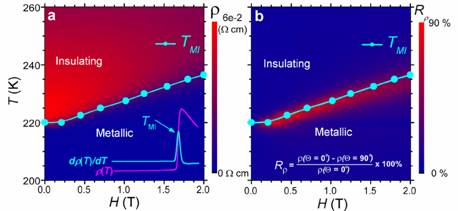August 25, 2009, "American Academy of Sciences" (Proceedings of the National Academy of Sciences) published the results of our latest research. Our partnership with Japan's National Institute for Materials Science, Institute of Physics, Chinese Academy of Sciences, Florida International University, Louisiana State University, in the perovskite-type manganese oxide single crystals was first observed unusually large anisotropic magnetoresistance (Anisotropic Maganetoresistance -AMR) effect, its value up to 90%, higher than the conventional ferromagnetic materials AMR effect nearly two orders of magnitude. We found that, AMR effect with the exception of the perovskite-type manganese oxide magnetic adjustable metal - insulator transition are closely related, and thus, for the exploration of new materials and their applications AMR provides a new way of thinking.
1857, W.Thomson resistivity of the material found with the change of the direction of the external magnetic field changes, the phenomenon is called AMR effect. AMR effect is widespread among all types of ferromagnetic materials, and has been widely applied to the read head and a magnetic sensor. Compared with the giant magnetoresistance (GMR), tunneling magnetoresistance (TMR), colossal magnetoresistance (CMR) effect, conventional ferromagnetic material in the AMR effect smaller value. For example, permalloy is AMR materials have been widely used, but at room temperature for only 1-2% of the value of its AMR. Due to the low sensitivity. In recent years, AMR devices are gradually being replaced by GMR and TMR devices. Our results indicate that, in the perovskite-type manganese oxide single crystal, even weak anisotropy can be induced large AMR effect, its value can be even higher than the GMR and TMR, AMR effect and the temperature anomaly and changes in the magnetic field has a non-monotonic relationship. We propose a model dimension as the above experimental results give a good explanation.
For details, see [PDF]. This research work has been the National Natural Science Foundation of China, Chinese Academy of Sciences Innovation Team International Partner Program, Zhejiang Province Outstanding Youth team project support.

Resistance perovskite-type manganese oxide La0.69Ca0.31MnO3 single crystal (left) and AMR (right) with changes in temperature and magnetic field